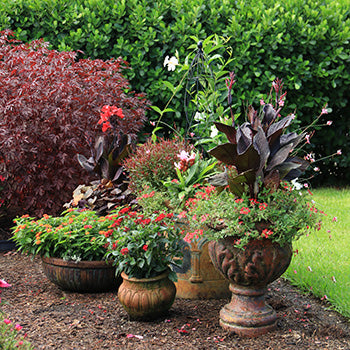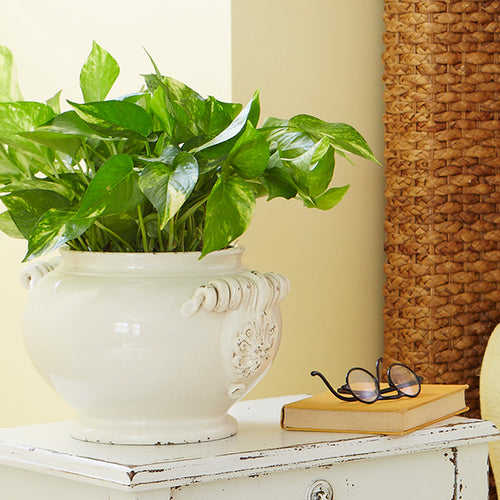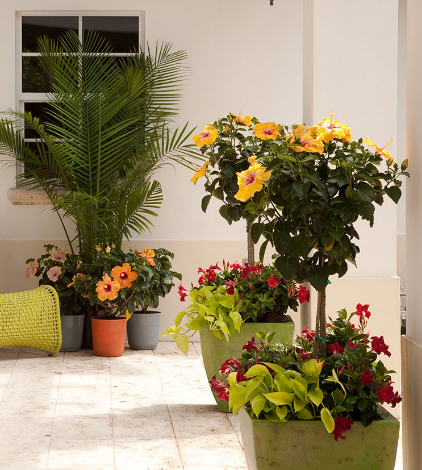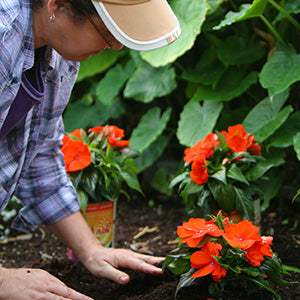By Justin Hancock
Visit your local garden center and you might be surprised at the variety of hibiscus available. These stunning, sun-loving plants come in just about every color, plus some wild multi-colored blooms. There’s also a wide variety of sizes, from compact selections to trees. You may see tropical types that can’t take frost and hardy types that will survive outdoors over the winter as far north as Canada. Check out our tips below to pick the best type and the best plants.
The Three Main Types of Hibiscus
There are three general categories of hibiscus you’ll commonly see.
Tropical Hibiscus (Hibiscus rosa-sinensis) are sun-loving shrubs that usually have shiny, dark green leaves and flowers in shades of yellow, orange, red, pink, purple, lavender, white, and bicolors. Being tropicals, they don’t like temperatures below 50F (10C) so if you live in a cold-winter climate, consider them annuals or bring them to a frost-free place for the winter and treat them like houseplants. Older varieties can grow 10 feet (3 meters) or more, but newer compact varieties stay much smaller.
Rose of Sharon (Hibiscus syriacus) is a hardy, sun-loving flowering shrub that survives temperatures as cold as -20F (-29C). These plants typically have smaller leaves and smaller flowers than their tropical cousins, but still grow large -- to 8 feet (2.5 meters) or more. The blooms appear mainly in shades of white, pink, purple, and red and can be single or double. Some varieties also have attractive foliage splashed with white.

Hardy Hibiscus (Hibiscus moscheutos), as its name suggests, is a cold-hardy, sun-loving perennial that survives -20F (-29C) temperatures. Unlike the tropical and rose of Sharon types, hardy hibiscus dies back to the ground every winter and comes back from the roots in late spring. (It comes back later in spring than most perennials -- so don’t give up on it!) Hardy hibiscus also features some of the largest flowers -- to 10 inches (25 centimeters) wide or more, and primarily in shades of red, pink, and white.
Once you decide on the right type of hibiscus, read the plant tags to make sure you have the right variety for your needs. If you’re looking for a hibiscus for a container garden on your sunny balcony, for example, you’ll probably want a tropical variety. Check the plant tag to see how big it grows.
Picking Hibiscus Plants
When shopping for hibiscus, look for plants that have dark green leaves. Too many yellow leaves may be a sign that the plant was stressed. Also look for lots of flower buds developing; hibiscus will often drop flower buds when allowed to dry out too much.
With hibiscus shrubs, it’s also helpful to select one that has a good overall shape. While you can prune them, shrub forms can take a while to grow into a more attractive plant. Because hibiscus flower from their new growth, one general rule is the more stems they have, the more blooms they can produce.
Don’t be afraid to slip a hibiscus out of its pot to look at the root system. The healthiest plants will have firm, white roots that just start to fill the pot. If there are lots of thick roots circling the inside of the pot, the plant is rootbound and will need more frequent watering. Avoid plants that have a lot of brown, squishy roots -- they may have been kept too wet and could be rotting.
Keeping Hibiscus Plants Healthy
After you bring your plant home, keep it healthy by repotting it into a slightly larger pot and use potting mix (avoid garden soil, which doesn’t drain well in pots and can introduce pests and diseases). Or plant it in the garden by digging a hole as deep as the pot, but about twice as wide. Be sure to water your hibiscus regularly: These sun-loving plants wilt quickly when they’re too dry. Promote lots of gorgeous blooms by fertilizing regularly with a general-purpose fertilizer formulated for use on container plants and follow the directions on the product packaging.


















